*New critters we’ve seen on our 2009 trip so far: beavers, groundhog, prairie dogs, big horn sheep, buffalo (bison), white tail deer, chipmunks, pronghorn, burros, pika, moose, Uinta ground squirrel, mountain goats, mule deer, fox, moose, black bears, elk, grizzly bear, wolf, longhorn beetle, otters
*New birds we’ve seen on our 2009 trip so far: wild turkeys, osprey, western meadowlark, mountain bluebird, sandhill cranes, Canadian geese, American white pelicans, trumpeter swans, killdeer, bald eagles, golden eagle, common merganser, great blue heron, raven, yellow-headed blackbird, Brewer’s blackbird, brown-headed cowbird, double-crested cormorant, Clark’s nutcracker, common goldeneye
*National Parks/Monuments visited on 2009 trip so far: 19
*State Parks visited on 2009 trip so far: 2“Thousands of tired, nerve-shaken, over-civilized people are beginning to find out that going to the mountain is going home; that wildness is a necessity; that mountain parks and reservations are useful not only as fountains of timber and irrigating rivers, but as fountains of life.” – John Muir, 1901
We discovered the above quote at the Craig Thomas Discovery & Visitor Center as we were leaving Grand Teton NP. We found it appropriate and felt it summed up our feelings about our summer trip thus far.

Traveling down Hwy. 89 we passed through the town of Jackson, WY, a famous getaway for skiers and celebrities, and home to massive elk antler arches that sit at each of the four corners of the town square. Nearly all the antlers were collected at the nearby National Elk Refuge as elk shed their antlers eac

h year. Further down the highway, we passed through the small town of Afton, WY, which is home to the world's largest elkhorn arch containing over 3,000 elk antlers. The arch is 75 feet wide and towers 18 feet above the four lanes of Hwy. 89 in downtown.
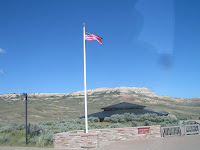
On the way to Salt Lake City, we had decided to visit Fossil Butte National Monument (
http://www.nps.gov/fobu), and the highway taking us there is designated as being part of the original Oregon & California Trails. Fossil Butte NM is basically in the middle of no

where, but they have a really nice visitor center that features over 80 fossils and fossil casts including a 13 foot crocodile. Since we now know that some national parks have no age limit on becoming a Junior Ranger, and we had just earned our badges at Grand Teton, the first thing we asked when we arrived was about their Junior Ranger program. Ranger Kelly explained that they actually have a Senior Ranger program, gave us the booklet (at no charge), and was more than willing to help with any sections we might get stuck on (some of these th

ings are harder than you might think!) We watched the video, checked out the exhibits, and observed a ranger in the lab preparing/cleaning a fossil, explaining the process and answering questions as he worked. I found it fascinating, and Russ decided he wouldn’t have the patience to do it. It took us about 45 min. to com

plete the booklet and earn our badges. We’ve decided we are going to ask at each park we visit about becoming a Junior Ranger as it is fun and really helps us learn so much more about the park we’re visiting.
Since we were driving the RV and towing the car, we weren’t able to take the scenic drive through the park as parts of it are narrow and steep and not recommended for RVs. Besides we needed to get to our next stop, the Wal-Mart parking lot in Evanston, WY, which is where we were to spend the night.

The next morning we were off to Salt Lake City, home of the Mormon Tabernacle Choir, and oh yeah, it’s the state capital, too. When we were planning this trip out west, I wanted to include Salt Lake City in the itinerary since we’d be so close and I’d always heard about the famous pin drop at the Tabernacl

e. Russ had visited the place about 40 years ago with his mom and sister, but I had never been there. You may recall that Salt Lake City was host to the 2002 Winter Olympics and just outside the city we passed the ski jumps and slalom and giant slalom runs which still bear the Olympic symbols.
We set up camp at the local KOA, only 12 blocks from Temple Square, and were disappointed to have finally hit h

ot weather. It was in the mid-90s and already we missed the cool mountain air. Salt Lake City is not nearly as big as we had imagined with a population under 200,000. Temple Square (
http://www.visittemplesquare.com/) is a beautifully landscaped 10-acre plot in downtown Salt Lake City, and one can tell that no expense has been spared to create the magnificent buildings and interiors found there. The centerpiece of the Square is the six spired Salt Lake

Temple, which was completed by the pioneer settlers in 1893, taking nearly 40 years to complete. The Temple is considered sacred and only members of the Mormon Faith are allowed to enter. Free tours of the rest of the grounds are given daily by missionaries of the church, and the day we went two young ladies, one from South Korea and the other from West Texas, led our tour. It began in the South Visitors Center with an explanation of the building of the Temple and then moved over to the Tabernacle, which is located directly across from the Temple. The round, do

me shaped Tabernacle was built by the pioneers as a place to worship while working on the Temple, is home to the Choir and the great Tabernacle Organ (more on that later), and is much smaller than I imagined. From here we walked across the lawn to the North Visitors Center, where an incredible 11-foot marble
Christus statue resides. Located on the second floor, you walk up a winding ramp that f
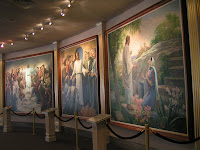
eatures an amazing painting of the heavens and the universe along the entire wall leading upstairs to the domed area. Here we were asked to have a seat while an overhead narration was played, reflecting on the majesty and wonder of God’s creations through the words of Jesus. The ladies offered to take our picture in front of the statue, and then we headed downstairs to complete the tour. Afterwards we wandered further around the center admiring the artwork and displays.

Every day an organ recital is held in the Tabernacle, and our tour ended just in time to catch this performance. The Salt Lake Tabernacle Organ has 206 ranks (sets), totaling 11,623 pipes, and are played from a five-manual keyboard console. Richard Elliott, Principal Tabernacle Organist, was featured on this day, and he began the 30-minute program by showcasing the acoustics of the Tabern
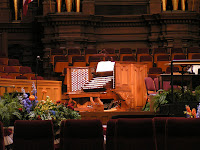
acle. With microphone off, he tore a piece of newspaper, dropped 3 straight pins one at a time, and then dropped a nail. All could be heard loud and clear throughout the entire facility. To show the versatility of the organ, he started with John Philip Souza’s
"Washington Post March", followed by five other numbers, some classical, some religious. As he played, the lights changed color behind the organ. No photos were allowed during the performance but before and after photos were fine.
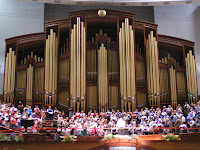
As luck would have it, the 360 member Mormon Tabernacle Choir was holding their weekly rehearsal that evening, and it was open to the public. During the summer and Christmas seasons, their rehearsals and weekly radio broadcast are held across the street in the 21,000 seat auditorium in Church’s Conference Center instead of in the Tabernacle because of the large number of visitors. The organ there is slightly smaller with only 130 ranks, totaling 7,708 pipes, and a full orchestra accompanies as well. We were able to sit about 10 ro

ws from the stage on the main floor so had an excellent view. The director wanted to finetune a passage of
“How Great Thou Art” and had a couple sections sing their parts together several times. It was interesting and slightly amusing to hear the director saying so many of the same things to this choir that I’ve heard from Sweet Adelines directors over the years, i.e. vowel placement, singing higher and lighter, etc. Just goes to show that we all need reminders and why rehearsals are necessary no matter what the level. Finally we got to hear the entire choir sing backed by the orchestra and the sound was phenomenal. We can only imagine what the sound would be like with the acoustics of the Tabernacle! They moved on to a couple other
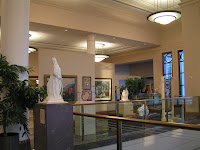
songs, and then we needed to leave as the choir was going to record and absolute quiet was needed in the auditorium.
Before leaving the Conference Center, we walked through and admired the works of art displayed there for the Eighth International Art Competition. The theme was
Remembering the Great Things of God, and the artwork varied widel

y in style, type, and medium with all contributors being members of the Mormon faith. Nearly 200 pieces of art were selected for the exhibition from 1,149 amateur and professional artists from 44 countries.
Sat. we took a drive to see the actual Great Salt Lake. First we stopped at the marina, watching boaters glide across the smooth water, and then drove down the road to the beach. At present the lake is about 75 miles long and 35 miles wide with a maximum depth of 33 feet and is 5 – 8 times saltier than the ocean because it has no outlet other than evapor

ation. The water has receded quite a bit and as I walked barefoot across the beach to the water, I could feel and hear the salt encrusted sand beneath my feet. There were quite a number of dead birds on the beach, and it smelled, but the water was warm and now I can say I’ve gotten my feet wet in the Great Salt Lake.

From here we are heading to Moab, UT, home to Arches National Park, and Canyonlands National Park is just down the road from there so we’ll see two in one stay.
 where, but they have a really nice visitor center that features over 80 fossils and fossil casts including a 13 foot crocodile. Since we now know that some national parks have no age limit on becoming a Junior Ranger, and we had just earned our badges at Grand Teton, the first thing we asked when we arrived was about their Junior Ranger program. Ranger Kelly explained that they actually have a Senior Ranger program, gave us the booklet (at no charge), and was more than willing to help with any sections we might get stuck on (some of these th
where, but they have a really nice visitor center that features over 80 fossils and fossil casts including a 13 foot crocodile. Since we now know that some national parks have no age limit on becoming a Junior Ranger, and we had just earned our badges at Grand Teton, the first thing we asked when we arrived was about their Junior Ranger program. Ranger Kelly explained that they actually have a Senior Ranger program, gave us the booklet (at no charge), and was more than willing to help with any sections we might get stuck on (some of these th ings are harder than you might think!) We watched the video, checked out the exhibits, and observed a ranger in the lab preparing/cleaning a fossil, explaining the process and answering questions as he worked. I found it fascinating, and Russ decided he wouldn’t have the patience to do it. It took us about 45 min. to com
ings are harder than you might think!) We watched the video, checked out the exhibits, and observed a ranger in the lab preparing/cleaning a fossil, explaining the process and answering questions as he worked. I found it fascinating, and Russ decided he wouldn’t have the patience to do it. It took us about 45 min. to com plete the booklet and earn our badges. We’ve decided we are going to ask at each park we visit about becoming a Junior Ranger as it is fun and really helps us learn so much more about the park we’re visiting.
plete the booklet and earn our badges. We’ve decided we are going to ask at each park we visit about becoming a Junior Ranger as it is fun and really helps us learn so much more about the park we’re visiting.  ation. The water has receded quite a bit and as I walked barefoot across the beach to the water, I could feel and hear the salt encrusted sand beneath my feet. There were quite a number of dead birds on the beach, and it smelled, but the water was warm and now I can say I’ve gotten my feet wet in the Great Salt Lake.
ation. The water has receded quite a bit and as I walked barefoot across the beach to the water, I could feel and hear the salt encrusted sand beneath my feet. There were quite a number of dead birds on the beach, and it smelled, but the water was warm and now I can say I’ve gotten my feet wet in the Great Salt Lake. 
No comments:
Post a Comment